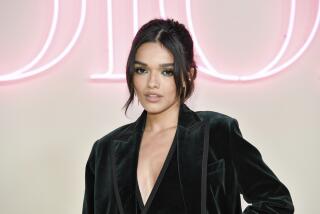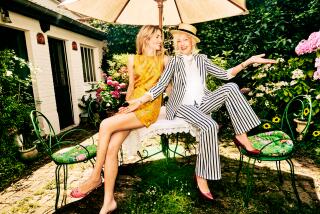Building Character From the Ground Up : Movies: The movements of models often provide the inspiration for the quirks and idiosyncrasies of animated stars.
- Share via
It could be described as life imitating animated art.Behind the animation of Snow White, Captain Hook, Sleeping Beauty and the Little Mermaid are people who modeled the characters, painstakingly acting out each movement, scene, song and line of dialogue. Even Bambi had a stand-in.
The rarely publicized truth is that animators draw heavily upon live models who lend realistic subtleties to animated forms.
“In animation, everything you do is based on real life,” said animator Glen Keane, who joined Walt Disney studios as an animator trainee in 1974. “Studying models really gives you the edge because your character is then based in reality--something that really moved and existed.”
The use of “live-action reference models” is a Disney practice that dates back to the 1930s. Actress Marge Champion was the model for Snow White; Hans Conried played Captain Hook in the 1953 release of “Peter Pan,” and Helene Stanley modeled a variety of roles in the 1950s, including Sleeping Beauty and Cinderella.
Walt Disney Pictures’ animated film, “The Rescuers Down Under,” features a mammoth mythical eagle modeled partly after six eagles residing at the Peregrine Fund in Boise, Ida. Keane studied the eagles before designing the character of Marahute, a majestic nine-foot eagle with a 40-foot wingspan. A huge stuffed American eagle on loan from the Los Angeles Museum of Natural History was also used, as well as an eagle skeleton.
Today, Keane’s studio is bereft of eagles but packed waist-high with an assortment of other beasts--models for the more woolly member of “The Beauty and the Beast,” the subject of a Disney animated feature to be released in late 1991. A wild boar head drools from one wall of Keane’s studio, just opposite a buffalo head and bearskin that crowd the entrance. Tacked around a drawing board are photographs of lions, leopards and gorillas. Perched to the right of Keane’s desk is a plaster model combining the most fearsome elements found in all the beasts.
As for the beast character, Keane, 37, said he is not yet certain if a human will be used as a model since complex animal-like movements would need to be interpreted. Beyond those comments, Disney would not elaborate, citing a longstanding policy of keeping films in production under tight security.
However, Keane elaborates on “The Rescuers Down Under,” a tale about Cody, an 8-year-old boy who struggles to protect Marahute from a sadistic poacher in Australia’s Outback. Marahute, the most detailed character that Keane and his assistants say they have labored over, appears in brief sequences in the beginning and end of the film.
To heighten the eagle’s realism, Keane first enlarged the bird, then shrunk its head, elongated its neck and wings, and puffed out its chest. Keane also slowed the bird’s wing movements to about 25% to 30% of an eagle’s flight speed. From his observations, Keane incorporated such detail as the flash of a nictitating membrane, a bird’s eyelid, across Marahute’s eye.
“We were told to pull out all the stops in the eagle sequences,” said Keane, who worked for one year on the Marahute scenes, which totaled only seven minutes of the 75-minute film. “If someone is going to tell me that, there are going to be veins on nictitating membranes and feathers that ruffle up majestically.”
Keane was referring to three seconds of film showing Marahute ruffling her feathers in pride over her brood of eggs. “We had seen great footage of eagles puffing up their feathers and we all agreed that we had to find some place in the film to use it,” said Brian Cleft, who supervises characters for “The Rescuers Down Under.”
Cleft and three others labored three days on that particular shot, packed with about 14,400 drawings, a bit of theater that could have easily been missed by viewers reaching down to retrieve a pail of popcorn.
To keep track of the 200 feathers, each was tagged with an employee name--from Disney Chairman Jeffrey Katzenberg to animation assistant Peggy Tonkongy.
Although the process may seem involved, it’s not as complicated as tracking actors who are used as live-action reference models.
Keane also was principal animator for “The Little Mermaid,” released in 1989. In that picture, he used actress Sherri Stoner as a model for Ariel, the Little Mermaid, to pick up nuances such as hand and arm gestures, facial features and the flow of hair when Stoner was filmed underwater. Stoner, who lives in Santa Monica, is modeling the character of Belle, the fairer half of “The Beauty and the Beast.”
Stoner, also a member of the Groundlings improvisational troupe in Los Angeles, is filmed two days a month for about a year and a half. She receives $500 a session for her work.
“The animator already knows the character’s personality, so I’m not there to define the character in any way,” said Stoner, who works in Sherman Oaks as a story editor at Tiny Toon Adventures, an animated TV children’s show produced by rival studio Warner Bros. “I provide little quirks and idiosyncrasies, personality traits, that will add to the character.”
Stoner, 31, said she often bit her lip during filming for “The Little Mermaid,” a natural quirk that animators built into Ariel.
“I started biting my lip when they filmed me as Belle, but they said I shouldn’t do it, it’s not her character,” said Stoner, who was hired after a Disney employee spotted her at a Groundlings performance. It was her petite size and long, dark hair, Stoner said, that landed her a job as an all-purpose Disney heroine.
Stoner is filmed in Disney’s cavernous “Imagineering” complex in Glendale, where directors assemble makeshift sets of apple crates and cardboard. Working off story boards containing the complete range of movements, both the model and the animated character must perform.
For “The Beauty and the Beast” sequences, Stoner said directors have her fend off menacing wolves that are in the shape of a mop, converse with a chatty cabinet and “walk around a lot with a book.” Other film segments were shot in Griffith Park, where Stoner rode a horse for a chase scene.
Stoner’s movements, however, are never taken directly off the film in a technique called “rotoscoping” that purists shun. With rotoscoping, the movements of the model are traced off the film and used as the animated version of the character.
After filming, animators print every sixth frame of film for study. According to Keane, models “hit an attitude” about every sixth frame that can often be worked into the animation. Animators also rough in the character, noting the way models form their words to dialogue and song.
“She would have a tilt of a head or a hand movement that we would pick up,” Keane said. “Animators tend to draw their own hands, and mine have too much muscle on them. Hers had an interesting tendency of folding in on themselves at odd angles. Sherri has a very sprightly, gangly quality about her. I tried to capture that.”
Upon viewing “The Little Mermaid,” Stoner said she could definitely see herself behind the character, and friends say they can readily spot her smile and hand gestures.
“It was really bizarre,” said Stoner, who was seated in her Tiny Toons office surrounded by the series characters. “You know how people get up in theaters and act out ‘The Rocky Horror Picture Show’? I know Ariel and Belle so well I would have no trouble getting up in front of the screen to do a one-woman performance.”
More to Read
Only good movies
Get the Indie Focus newsletter, Mark Olsen's weekly guide to the world of cinema.
You may occasionally receive promotional content from the Los Angeles Times.










